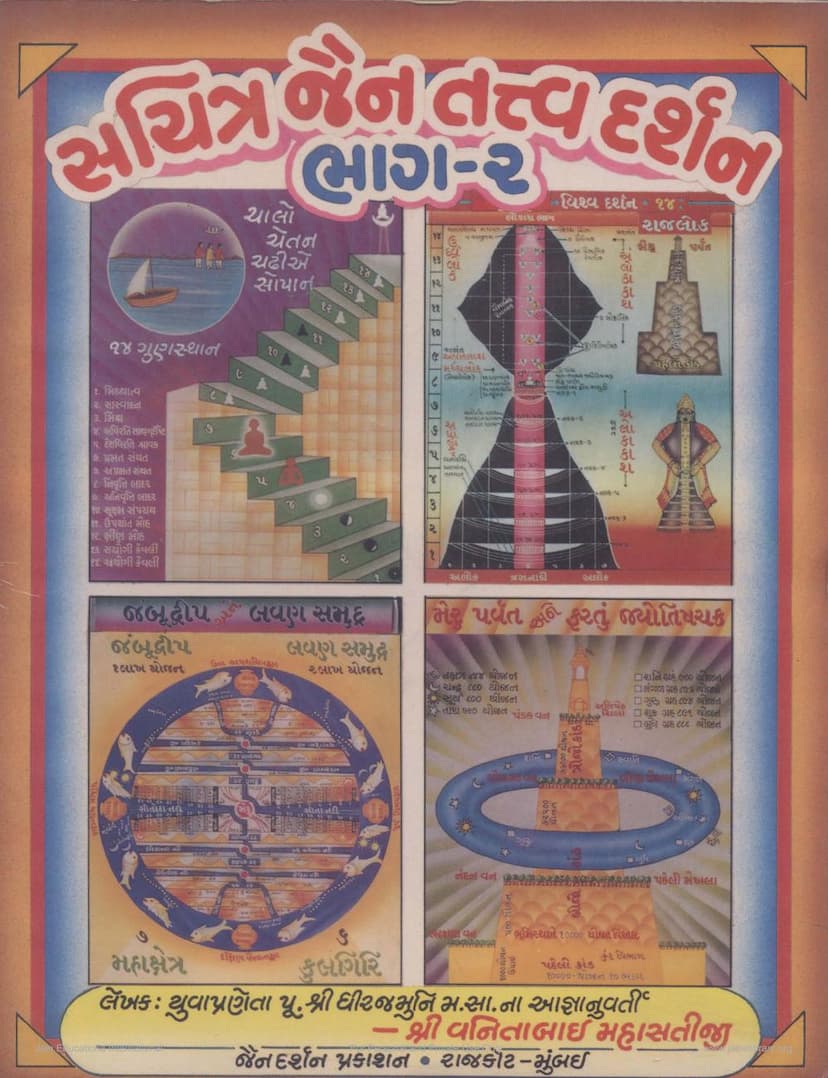Sachitra Jain Tattvadarshan Part 02
Added to library: September 2, 2025

Summary
Here's a comprehensive summary of the provided Jain text, "Sachitra Jain Tattvadarshan Part 02," based on the translated content.
Book Title: Sachitra Jain Tattvadarshan Part 02 (Illustrated Jain Philosophical Vision Part 02) Author: Vanitabai Mahasati Publisher: Jain Darshan Prakashan Catalog Link: https://jainqq.org/explore/005345/1
This book is the second part of a series aimed at presenting Jain philosophy in an illustrated, question-and-answer format. It is dedicated to providing a clear and accessible understanding of core Jain concepts, particularly for younger generations.
Overall Purpose and Approach:
- Illuminating Jain Wisdom: The book strives to make profound Jain teachings understandable and engaging, especially for children and youth.
- Question-and-Answer Format: This pedagogical approach is used to foster curiosity and provide step-by-step, in-depth knowledge.
- Clarity and Accuracy: The text emphasizes simple language, lucidity, and accuracy in presenting information, including statistical data, maps, and illustrations.
- Spiritual Journey: The book uses the metaphor of climbing steps ("Chalo, Chetan! Chadhiye Sopan!") to represent the soul's journey through the 14 spiritual stages (Gunasthanas).
Key Concepts Covered:
The book is structured around several fundamental Jain philosophical topics:
-
Gunasthanas (Spiritual Stages): This is a major focus, detailing the 14 stages of spiritual development an soul undergoes.
- Purpose of Gunasthanas: They illustrate the soul's progress in shedding impurities (karmas), revealing its inherent qualities (knowledge, perception, conduct), and moving towards liberation.
- The 14 Gunasthanas: The book lists and explains each of the 14 stages:
- Mithyatva (False Belief)
- Sāsvādana (Taste of Right Faith)
- Mishra (Mixed Faith)
- Avirati Samyagdr̥ṣṭi (Unrestrained Right Faith)
- Deśavirati (Partial Restraint)
- Pramatta Saṁyati (Careless Ascetic)
- Apramatta Saṁyati (Careful Ascetic)
- Nivr̥tti Bādara (Apūrvakaraṇa) (Subtle stage of progress)
- Anivr̥tti Bādara (Saṁparāya) (Further progress without regression)
- Sūkṣma Saṁparāya (Subtle Greed)
- Upśānta Moha (Pacified Delusion)
- Kṣīṇa Moha (Destroyed Delusion)
- Sayogi Kevalī (Omniscient with activity)
- Ayogi Kevalī (Omniscient without activity - Liberation)
- Detailed Explanation: For each Gunasthana, the book answers questions about its nature, the types of beings present, the shedding of impurities, and the path to progress. It elaborates on concepts like right faith (Samyagdarshan), its types (Kṣayika, Upśama, Kṣayopśama, Vedaka, Sāsvādana), and the path to achieving it through practices like meditation and virtuous conduct.
- Detailed analysis of each Gunasthana, including the karmic conditions, stages of purification, and the specific types of actions (kriya) and states of consciousness (bhava) associated with each.
-
Lokswaroop (The Universe/Cosmos): The book describes the structure and vastness of the Jain universe.
- Lok and Alok: It differentiates between the inhabited universe (Lok) containing the fundamental substances (dravyas) and the void beyond (Alok).
- Structure: The Lok is described as having a specific, complex shape (like two stacked bowls and a third inverted one) and being measured in "rajus."
- Three Realms: The Lok is divided into three main parts: Adholok (lower realm, housing hell beings), Tiryak Lok (middle realm, where humans, animals, and celestial beings reside), and Urdhva Lok (upper realm, housing heavens and the Siddha Shila).
- Jambudweepa: A detailed description of Jambudweepa, the central continent within the Tiryak Lok, is provided. This includes its dimensions, shape (like a chariot wheel or flat plate), the central Meru mountain, the rivers, the divisions into Karma and Akarmabhumi, and the lineage of Tirthankaras and Chakravartis.
- Adhai Dweepa (2.5 Continents): The concept of Adhai Dweepa (Jambudweepa, Dhatkikhand, and Ardha-Pushkara) is explained as the region where humans are born, capable of achieving liberation. The boundaries of this region are marked by the Manushyottar mountain.
- Celestial Bodies: The text describes the celestial beings (Jyotishi Devas) like the Sun, Moon, planets, and stars, their movements around Meru mountain, and their respective families and characteristics.
- Eternity of the Lok: The Lok is described as eternal, uncreated, and existing through all time (Dhrūv, Nitya, Śāśvata).
Illustrations:
The title "Sachitra" (Illustrated) indicates the book's use of visuals. The provided pages show diagrams of:
- The 14 Gunasthanas.
- Various celestial beings and their abodes.
- The structure of the Lok.
- Detailed maps and representations of Jambudweepa and its features (mountains, rivers, regions).
- The cosmic wheel showing planetary and stellar bodies.
Authorship and Dedication:
- The book is attributed to Vanitabai Mahasati, a disciple of Shri Dhirajmuni Maharaj Saheb.
- The book is dedicated to her spiritual gurus, including her mother, Mahasatiji.
Publisher's Note:
- The publisher, Jain Darshan Prakashan, expresses satisfaction with the positive reception of Part 1 and aims to spread knowledge affordably.
- It thanks donors and acknowledges the printing work done by "Studio Bahar-Mumbai" for the four-color illustrations.
Target Audience and Impact:
- The book is intended to be a valuable resource for students, religious teachers, saints, and anyone seeking to understand Jain philosophy.
- It aims to instill correct beliefs and guide individuals on the spiritual path towards self-realization and liberation.
In essence, "Sachitra Jain Tattvadarshan Part 02" serves as an illustrated guide to the fundamental cosmological and spiritual framework of Jainism, presented in an accessible question-and-answer format to facilitate learning and spiritual growth.